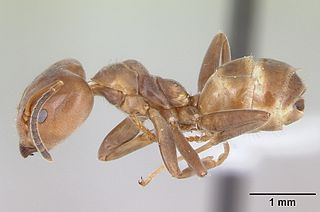
Ernst Walter Mayr was one of the 20th century's leading evolutionary biologists. He was also a renowned taxonomist, tropical explorer, ornithologist, philosopher of biology, and historian of science. His work contributed to the conceptual revolution that led to the modern evolutionary synthesis of Mendelian genetics, systematics, and Darwinian evolution, and to the development of the biological species concept.

The mousebirds are a family of birds. They are the sister group to the clade Eucavitaves, which includes the cuckoo roller (Leptosomiformes), trogons (Trogoniformes), Bucerotiformes, Coraciformes and Piciformes. The mousebirds are therefore given order status as Coliiformes. This group is confined to sub-Saharan Africa, and is the only bird order confined entirely to that continent. They had a wider range in prehistoric times, with a widespread distribution in Europe and North America during the Paleocene.
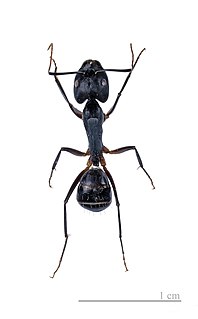
The Formicinae are a subfamily within the Formicidae containing ants of moderate evolutionary development.

Ponerinae is a subfamily of ants in the Poneromorph subfamilies group, with about 1,600 species in 47 extant genera, including Dinoponera gigantea - one of the world's largest species of ant. Mated workers have replaced the queen as the functional egg-layers in several species of ponerine ants. In such queenless species, the reproductive status of workers can only be determined through ovarian dissections.

Myrmicinae is a subfamily of ants, with about 140 extant genera; their distribution is cosmopolitan. The pupae lack cocoons. Some species retain a functional sting. The petioles of Myrmicinae consist of two nodes. The nests are permanent and in soil, rotting wood, under stones, or in trees.

Dolichoderinae is a subfamily of ants, which includes species such as the Argentine ant, the erratic ant, the odorous house ant, and the cone ant. The subfamily presents a great diversity of species throughout the world, distributed in different biogeographic regions, from the Palearctic, Nearctic, Afrotropical region and Malaysia, to the Middle East, Australian, and Neotropical regions.
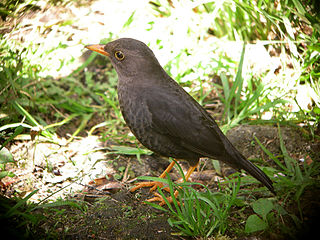
The island thrush is a common forest bird in the thrush family. Almost 50 subspecies have been described, ranging from Taiwan, through South East Asia and Melanesia, to Samoa, exhibiting great differences in plumage. Several subspecies are threatened and three have already become extinct.
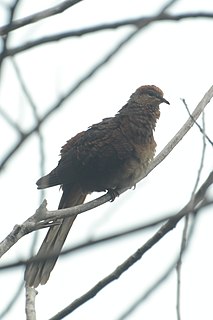
The Amboyna cuckoo-dove is a dove in the genus Macropygia found in the Moluccas and New Guinea. It was one of three new species defined when the slender-billed cuckoo-dove was split up in 2016 and retains the Latin binomial of the former species.[1]

The buff-banded rail is a distinctively coloured, highly dispersive, medium-sized rail of the rail family, Rallidae. This species comprises several subspecies found throughout much of Australasia and the south-west Pacific region, including the Philippines, New Guinea, Australia, New Zealand, and numerous smaller islands, covering a range of latitudes from the tropics to the Subantarctic.
The species problem is the set of questions that arises when biologists attempt to define what a species is. Such a definition is called a species concept; there are at least 26 recognized species concepts. A species concept that works well for sexually reproducing organisms such as birds is useless for species that reproduce asexually, such as bacteria. The scientific study of the species problem has been called microtaxonomy.

Gustav L. Mayr was an Austrian entomologist and professor in Budapest and Vienna. He specialised in Hymenoptera, being particularly known for his studies of Formicidae.

Aphaenogaster is a genus of myrmicine ants. About 200 species have been described, including 18 fossil species. They occur worldwide except in South America south of Colombia, Sub-Saharan Africa, and Antarctica.

Crematogaster is an ecologically diverse genus of ants found worldwide, which are characterised by a distinctive heart-shaped gaster (abdomen), which gives them one of their common names, the Saint Valentine ant. Members of this genus are also known as cocktail ants because of their habit of raising their abdomens when alarmed. Most species are arboreal. These ants are sometimes known as acrobat ants.

Dasornis is a genus of the prehistoric pseudotooth birds. These were probably rather close relatives of either pelicans and storks, or of waterfowl, and are here placed in the order Odontopterygiformes to account for this uncertainty.

Dolichoderus is a genus of ants found worldwide.
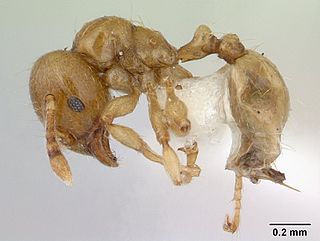
Allomerus is a Neotropical genus of small ants in the subfamily Myrmicinae. Its eight species are known from the forests of South America, where they live in plant cavities and structures.
Megachile azteca is a species of bee in the family Megachilidae. It was described by Cresson in 1878.

Leptomyrmecini is a tribe of Dolichoderinae ants with 16 genera and two extinct genera.

The scientific study of speciation — how species evolve to become new species — began around the time of Charles Darwin in the middle of the 19th century. Many naturalists at the time recognized the relationship between biogeography and the evolution of species. The 20th century saw the growth of the field of speciation, with major contributors such as Ernst Mayr researching and documenting species' geographic patterns and relationships. The field grew in prominence with the modern evolutionary synthesis in the early part of that century. Since then, research on speciation has expanded immensely.

